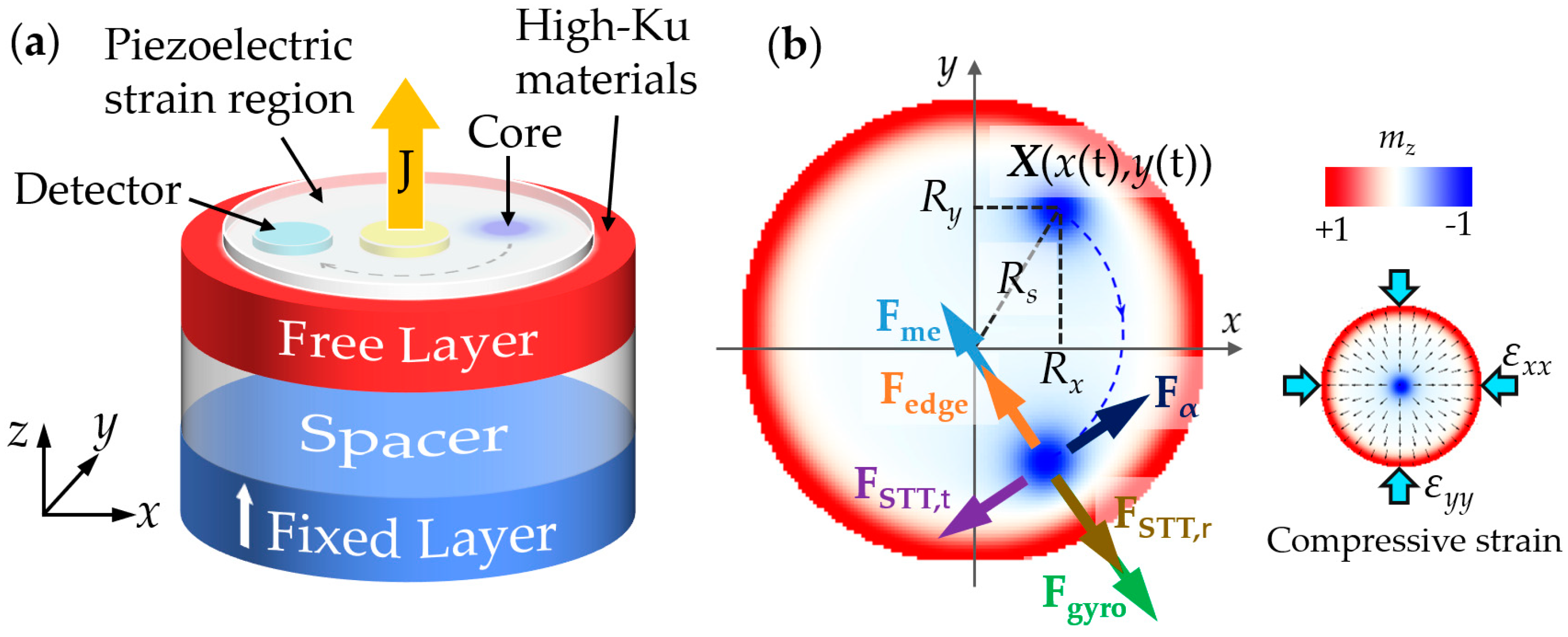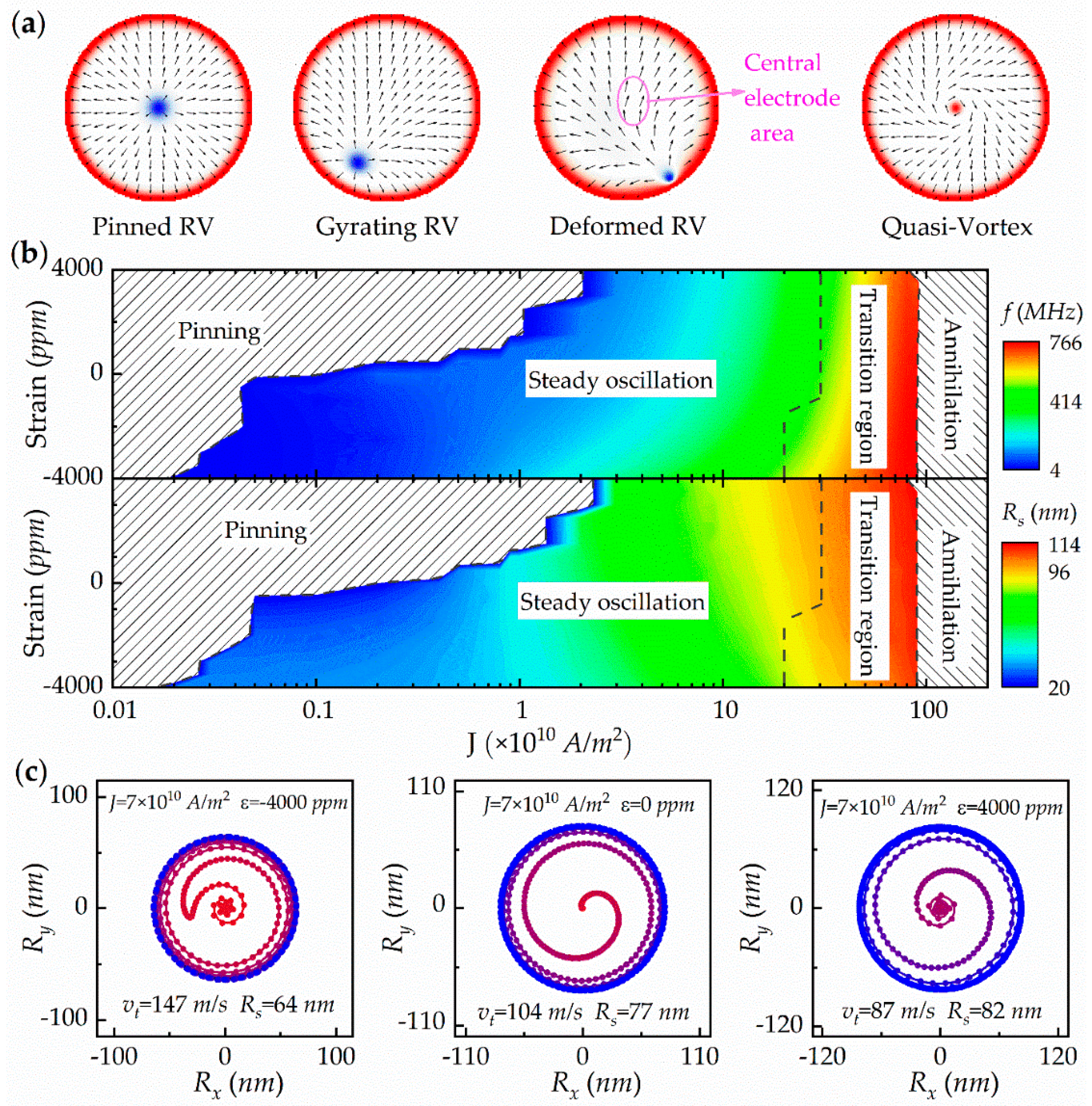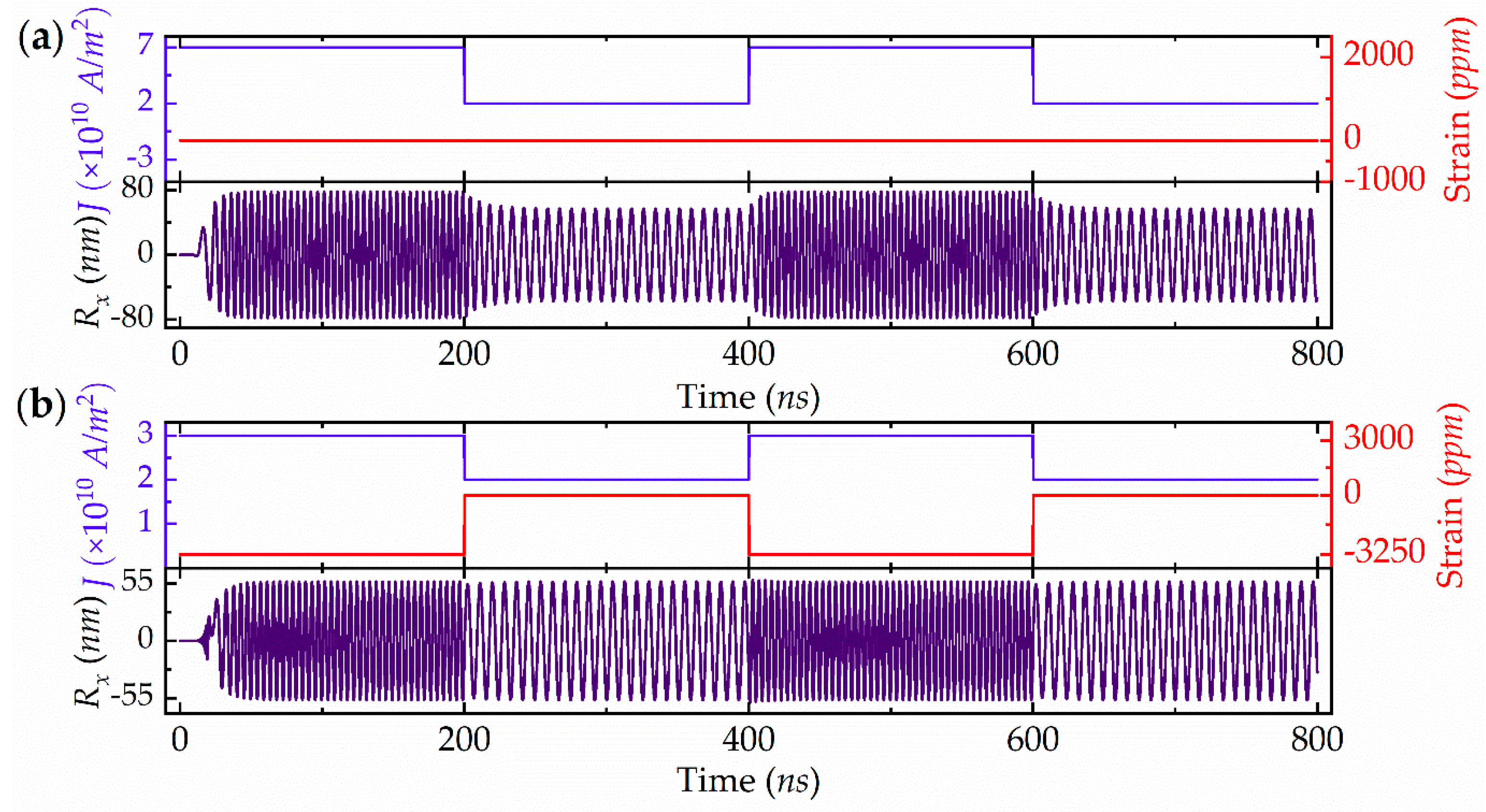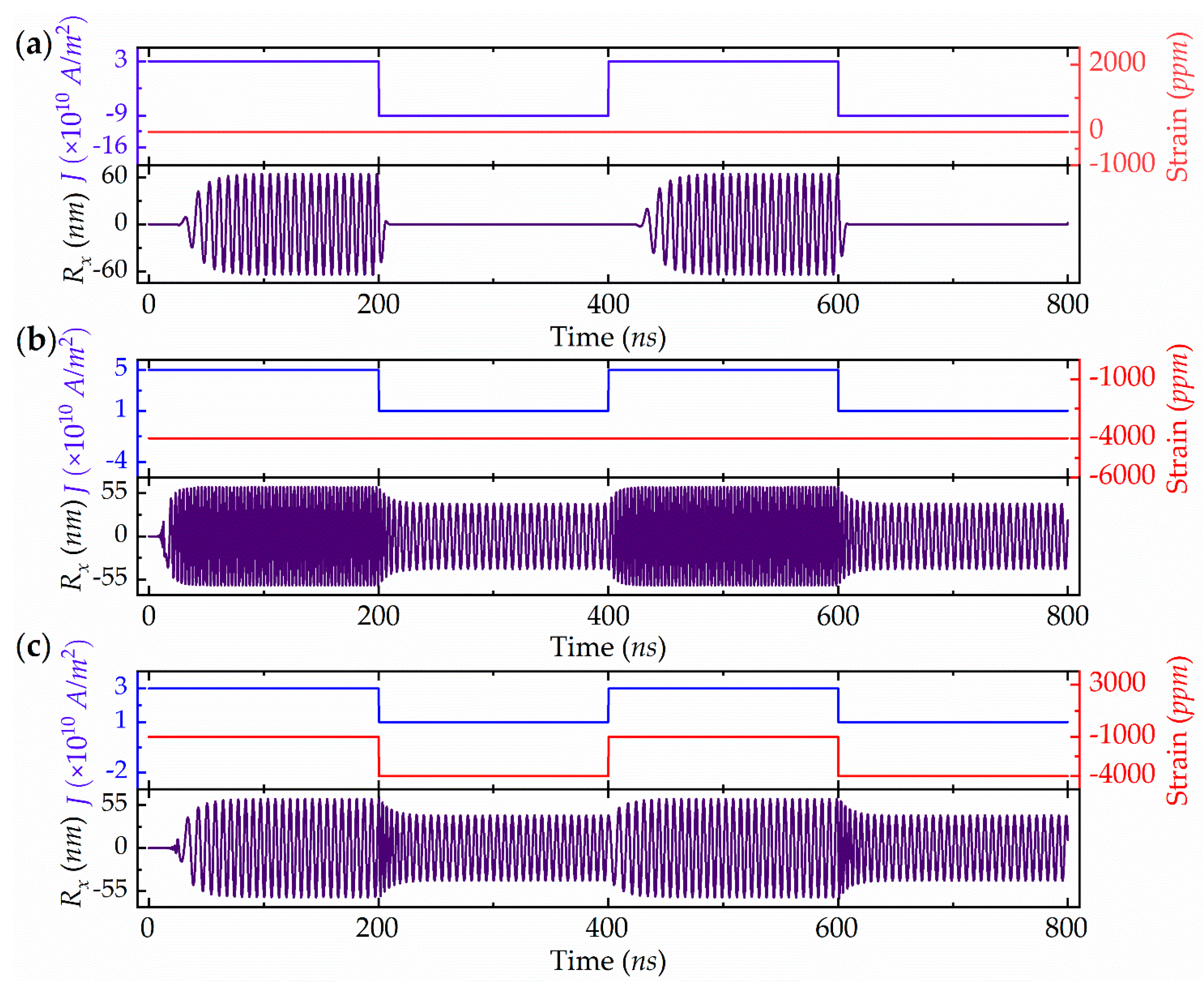Design of a Radial Vortex-Based Spin-Torque Nano-Oscillator in a Strain-Mediated Multiferroic Nanostructure for BFSK/BASK Applications
Abstract
:1. Introduction
2. Model and Simulation
3. Results and Discussion
4. Conclusions
Author Contributions
Funding
Data Availability Statement
Conflicts of Interest
References
- Kiselev, S.I.; Sankey, J.C.; Krivorotov, I.N.; Emley, N.C.; Schoelkopf, R.J.; Buhrman, R.A.; Ralph, D.C. Microwave oscillations of a nanomagnet driven by a spin-polarized current. Nature 2003, 425, 380–383. [Google Scholar] [CrossRef] [PubMed] [Green Version]
- Locatelli, N.; Vodenicarevic, D.; Zhao, W.S.; Klein, J.O.; Grolliert, J.; Querlioz, D. Vortex-based spin transfer oscillator compact model for IC design. In Proceedings of the International Symposium on Circuits and Systems (ISCAS), Lisbon, Portugal, 24–27 May 2015; pp. 589–592. [Google Scholar] [CrossRef] [Green Version]
- Choi, H.S.; Kang, S.Y.; Cho, S.J.; Oh, I.Y.; Shin, M.; Park, H.; Jang, C.; Min, B.C.; Kim, S.I.; Park, S.Y.; et al. Spin nano-oscillator-based wireless communication. Sci. Rep. 2014, 4, 5486. [Google Scholar] [CrossRef] [PubMed]
- Tarequzzaman, M.; Böhnert, T.; Decker, M.; Costa, J.D.; Borme, J.; Lacoste, B.; Paz, E.; Jenkins, A.S.; Serrano-Guisan, S.; Back, C.H.; et al. Spin torque nano-oscillator driven by combined spin injection from tunneling and spin Hall current. Commun. Phys. 2019, 2, s42005–s42019. [Google Scholar] [CrossRef] [Green Version]
- Ralph, D.C.; Stiles, M.D. Spin transfer torques. J. Magn. Magn. Mater. 2008, 320, 1190–1216. [Google Scholar] [CrossRef]
- Manchon, A.; Železný, J.; Miron, I.M.; Jungwirth, T.; Sinova, J.; Thiaville, A.; Garello, K.; Gambardella, P. Current-induced spin-orbit torques in ferromagnetic and antiferromagnetic systems. Rev. Mod. Phys. 2019, 91, 035004. [Google Scholar] [CrossRef] [Green Version]
- Demidov, V.E.; Urazhdin, S.; Ulrichs, H.; Tiberkevich, V.; Slavin, A.; Baither, D.; Schmitz, G.; Demokritov, S.O. Magnetic nano-oscillator driven by pure spin current. Nat. Mater. 2012, 11, 1028–1031. [Google Scholar] [CrossRef]
- Zeng, Z.M.; Finocchio, G.; Jiang, H.W. Spin transfer nano-oscillators. Nanoscale 2013, 5, 2219–2231. [Google Scholar] [CrossRef] [Green Version]
- Demidov, V.E.; Urazhdin, S.; Demokritov, S.O. Direct observation and mapping of spin waves emitted by spin-torque nano-oscillators. Nat. Mater. 2010, 9, 984–988. [Google Scholar] [CrossRef]
- Macià, F.; Kent, A.D. Magnetic droplet solitons. J. Appl. Phys. 2020, 128, 100901. [Google Scholar] [CrossRef]
- Lendínez, S.; Statuto, N.; Backes, D.; Kent, A.D.; Macià, F. Observation of droplet soliton drift resonances in a spin-transfer-torque nanocontact to a ferromagnetic thin film. Phys. Rev. B 2015, 92, 174426. [Google Scholar] [CrossRef] [Green Version]
- Hrkac, G.; Keatley, P.S.; Bryan, M.T.; Butler, K. Magnetic vortex oscillators. J. Phys. D 2015, 48, 453001. [Google Scholar] [CrossRef]
- Li, H.N.; Wang, D.; Zhao, Y.F.; Hu, Y.; Fan, Z.W.; Liu, Y. Influence of Dzyaloshinskii-Moriya interaction on the magnetic vortex gyration driven by a spin-polarized current. J. Magn. Magn. Mater. 2020, 515, 167291. [Google Scholar] [CrossRef]
- Jin, C.D.; Ma, Y.X.; Song, C.K.; Xia, H.Y.; Wang, J.N.; Zhang, C.L.; Zeng, Z.Z.; Wang, J.B.; Liu, Q.F. High-frequency spin transfer nano-oscillator based on the motion of skyrmions in an annular groove. New J. Phys. 2020, 22, 033001. [Google Scholar] [CrossRef]
- Cui, S.T.; Zhu, M.M.; Qiu, Y.; Guo, R.D.; Wu, G.H.; Yu, G.L.; Zhou, H.M. Micromagnetic prediction strain and current co-mediated spindynamics in skyrmion-based spin-torque nano-oscillator. J. Phys. D 2022, 55, 175003. [Google Scholar] [CrossRef]
- Voto, M.; Lopez-Diaz, L.; Martinez, E. Pinned domain wall oscillator as a tuneable direct current spin wave emitter. Sci. Rep. 2017, 7, 13559. [Google Scholar] [CrossRef] [Green Version]
- Yin, H.; Lu, Z.; Chen, C.; Li, S.; Wang, W.; Li, C.; Cheng, M.; Zhang, Z.; Xiong, R. Current driven spin oscillation in PMA/IMA composite nanowires-a novel spin torque based nano-oscillators. Nanotechnology 2019, 30, 21LT01. [Google Scholar] [CrossRef] [PubMed]
- Feng, Y.H.; Zhu, H.K.; Zhang, X.; Xiang, G. Ultrahigh frequency spin-torque nano-oscillator based on bilayer-skyrmions. J. Magn. Magn. Mater. 2022, 543, 168641. [Google Scholar] [CrossRef]
- Pribiag, V.S.; Krivorotov, I.N.; Fuchs, G.D.; Braganca, P.M.; Ozatay, O.; Sankey, J.C.; Ralph, D.C.; Buhrman, R.A. Magnetic vortex oscillator driven by d.c. spin-polarized current. Nat. Phys. 2007, 3, 498–503. [Google Scholar] [CrossRef]
- Tsunegi, S.; Yakushiji, K.; Fukushima, A.; Yuasa, S.; Kubota, H. Microwave emission power exceeding 10 μW in spin torque vortex oscillator. Appl. Phys. Lett. 2016, 109, 252402. [Google Scholar] [CrossRef]
- Siracusano, G.; Tomasello, R.; Giordano, A.; Puliafito, V.; Azzerboni, B.; Ozatay, O.; Carpentieri, M.; Finocchio, G. Magnetic Radial Vortex Stabilization and Efficient Manipulation Driven by the Dzyaloshinskii-Moriya Interaction and Spin-Transfer Torque. Phys. Rev. Lett. 2016, 117, 087204. [Google Scholar] [CrossRef]
- Karakas, V.; Gokce, A.; Habiboglu, A.T.; Arpaci, S.; Ozbozduman, K.; Cinar, I.; Yanik, C.; Tomasello, R.; Tacchi, S.; Siracusano, G.; et al. Observation of Magnetic Radial Vortex Nucleation in a Multilayer Stack with Tunable Anisotropy. Sci. Rep. 2018, 8, 7180. [Google Scholar] [CrossRef] [PubMed] [Green Version]
- Li, C.; Wang, S.; Xu, N.; Yang, X.K.; Liu, B.J.; Yang, B.B.; Fang, L. Spin-torque nano-oscillators based on radial vortex in the presence of interface Dzyaloshinskii-Moriya interaction. J. Magn. Magn. Mater. 2020, 498, 166155. [Google Scholar] [CrossRef]
- Zhu, M.M.; Hu, H.M.; Cui, S.T.; Li, Y.T.; Zhou, X.P.; Qiu, Y.; Guo, R.D.; Wu, G.H.; Yu, G.L.; Zhou, H.M. Strain-driven radial vortex core reversal in geometric confined multiferroic heterostructures. Appl. Phys. Lett. 2021, 118, 262412. [Google Scholar] [CrossRef]
- Zhang, X.L.; Chen, H.-H.; Zhang, Z.Z.; Liu, Y.W. Electric-field assisted spin torque nano-oscillator and binary frequency shift keying modulation. J. Magn. Magn. Mater. 2018, 452, 458–463. [Google Scholar] [CrossRef]
- Khalsa, G.; Stiles, M.D.; Grollier, J. Critical current and linewidth reduction in spin-torque nano-oscillators by delayed self-injection. Appl. Phys. Lett. 2015, 106, 242402. [Google Scholar] [CrossRef] [Green Version]
- Tamaru, S.; Kubota, H.; Yakushiji, K.; Yuasa, S.; Fukushima, A. Extremely Coherent Microwave Emission from Spin Torque Oscillator Stabilized by Phase Locked Loop. Sci. Rep. 2015, 5, 18134. [Google Scholar] [CrossRef] [Green Version]
- Ruiz-Calaforra, A.; Purbawati, A.; Brächer, T.; Hem, J.; Murapaka, C.; Jiménez, E.; Mauri, D.; Zeltser, A.; Katine, J.A.; Cyrille, M.C.; et al. Frequency shift keying by current modulation in a MTJ-based STNO with high data rate. Appl. Phys. Lett. 2017, 111, 082401. [Google Scholar] [CrossRef]
- Zeng, L.; Liu, Y.; Chen, H.H.; Zhou, Y.; Zhang, D.M.; Zhang, Y.G.; Zhao, W.S. Robust phase shift keying modulation method for spin torque nano-oscillator. Nanotechnology 2020, 31, 375205. [Google Scholar] [CrossRef]
- Ma, R.; Purbawati, A.; Kreisig, M.; Protze, F.; Ruiz-Calaforra, A.; Hem, J.; Ebels, U.; Ellinger, F. Spin torque oscillator based BFSK modulation. In Proceedings of the Research in Microelectronics and Electronics (PRIME), Giardini Naxos-Taormina, Italy, 12–15 June 2017; pp. 1–4. [Google Scholar] [CrossRef] [Green Version]
- Sharma, R.; Sisodia, N.; Akerman, J.; Muduli, P.K. Enhanced Modulation Bandwidth of a Magnetic Tunnel Junction-Based Spin Torque Nano-Oscillator Under Strong Current Modulation. IEEE Electron Device Lett. 2021, 42, 1886–1889. [Google Scholar] [CrossRef]
- Shirahata, Y.; Shiina, R.; González, D.L.; Kévin, J.A.; Franke, E.W.; Itoh, M.; Pertsev, N.A.; van Dijken, S.; Taniyama, T. Electric-field switching of perpendicularly magnetized multilayers. NPG Asia Mater. 2015, 7, e198. [Google Scholar] [CrossRef] [Green Version]
- Ma, Y.X.; Song, C.K.; Jin, C.D.; Zhu, Z.T.; Feng, H.M.; Xia, H.Y.; Wang, J.N.; Zeng, Z.Z.; Wang, J.B.; Liu, Q.F. Nano-oscillator based on radial vortex by overcoming the switching of core. J. Phys. D 2020, 53, 195004. [Google Scholar] [CrossRef]
- Fert, A.; Reyren, N.; Cros, V. Magnetic skyrmions: Advances in physics and potential applications. Nat. Rev. Mater. 2017, 2, 17031. [Google Scholar] [CrossRef]
- Vansteenkiste, A.; Leliaert, J.; Dvornik, M.; Helsen, M.; Garcia-Sanchez, F.; Van Waeyenberge, B. The design and verification of MuMax3. AIP Adv. 2014, 4, 107133. [Google Scholar] [CrossRef] [Green Version]
- Abert, C. Micromagnetics and spintronics: Models and numerical methods. Eur. Phys. J. B 2019, 92, 120. [Google Scholar] [CrossRef] [Green Version]
- Slonczewski, J.C. Current-driven excitation of magnetic multilayers. J. Magn. Magn. Mater. 1996, 159, L1–L7. [Google Scholar] [CrossRef]
- Hu, J.M.; Yang, T.N.; Chen, L.Q. Stability and dynamics of skyrmions in ultrathin magnetic nanodisks under strain. Acta Mater. 2020, 183, 145–154. [Google Scholar] [CrossRef]
- Yu, G.L.; Xu, X.F.; Qiu, Y.; Yang, H.; Zhu, M.; Zhou, H.M. Strain-modulated magnetization precession in skyrmion-based spin transfer nano-oscillator. Appl. Phys. Lett. 2021, 118, 142403. [Google Scholar] [CrossRef]





Publisher’s Note: MDPI stays neutral with regard to jurisdictional claims in published maps and institutional affiliations. |
© 2022 by the authors. Licensee MDPI, Basel, Switzerland. This article is an open access article distributed under the terms and conditions of the Creative Commons Attribution (CC BY) license (https://creativecommons.org/licenses/by/4.0/).
Share and Cite
Hu, H.; Yu, G.; Li, Y.; Qiu, Y.; Zhu, H.; Zhu, M.; Zhou, H. Design of a Radial Vortex-Based Spin-Torque Nano-Oscillator in a Strain-Mediated Multiferroic Nanostructure for BFSK/BASK Applications. Micromachines 2022, 13, 1056. https://doi.org/10.3390/mi13071056
Hu H, Yu G, Li Y, Qiu Y, Zhu H, Zhu M, Zhou H. Design of a Radial Vortex-Based Spin-Torque Nano-Oscillator in a Strain-Mediated Multiferroic Nanostructure for BFSK/BASK Applications. Micromachines. 2022; 13(7):1056. https://doi.org/10.3390/mi13071056
Chicago/Turabian StyleHu, Huimin, Guoliang Yu, Yiting Li, Yang Qiu, Haibin Zhu, Mingmin Zhu, and Haomiao Zhou. 2022. "Design of a Radial Vortex-Based Spin-Torque Nano-Oscillator in a Strain-Mediated Multiferroic Nanostructure for BFSK/BASK Applications" Micromachines 13, no. 7: 1056. https://doi.org/10.3390/mi13071056
APA StyleHu, H., Yu, G., Li, Y., Qiu, Y., Zhu, H., Zhu, M., & Zhou, H. (2022). Design of a Radial Vortex-Based Spin-Torque Nano-Oscillator in a Strain-Mediated Multiferroic Nanostructure for BFSK/BASK Applications. Micromachines, 13(7), 1056. https://doi.org/10.3390/mi13071056





